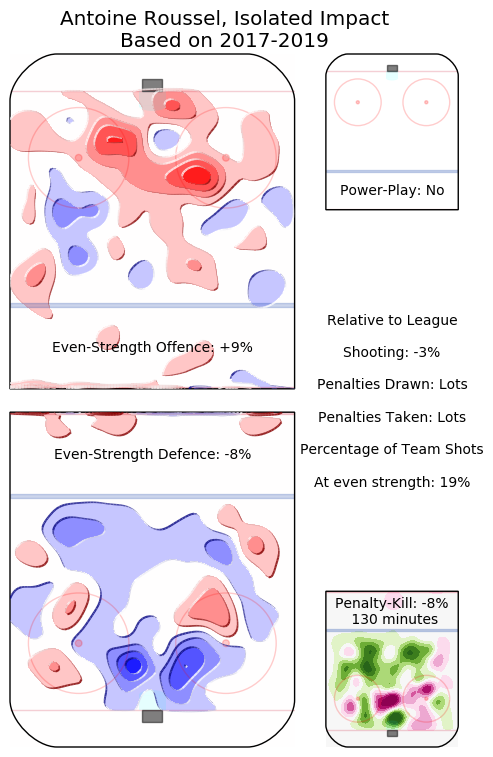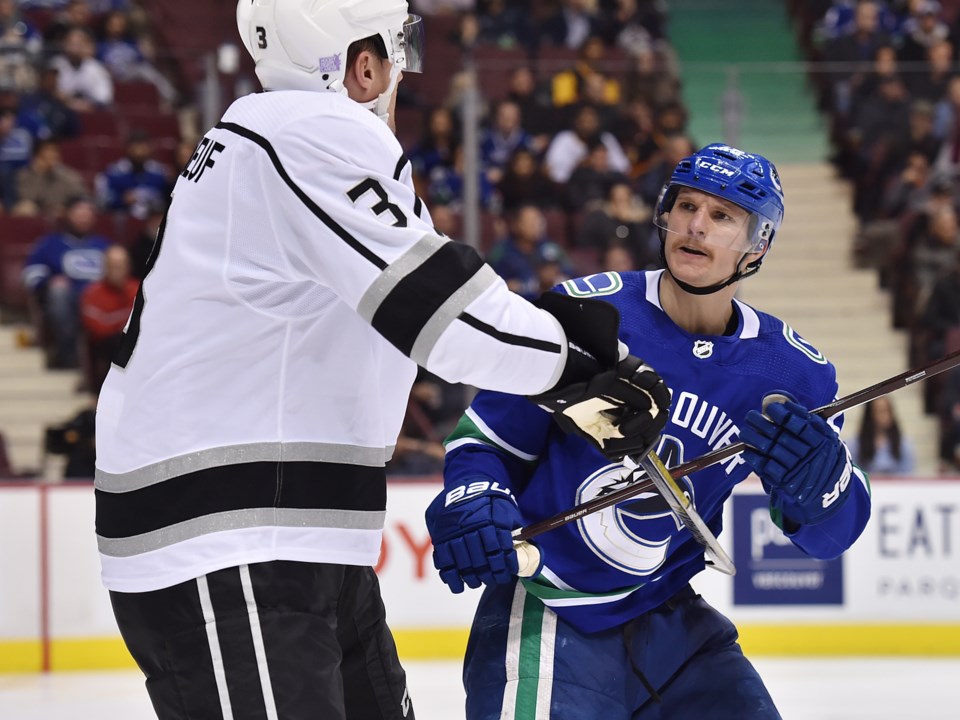Though three of their young players came painfully close, the Canucks didn’t have a single 30-goal scorer last season.
Elias Pettersson led the team with 28 goals and surely would have reached 30 if not for injuries. The same is true for Brock Boeser, who tallied 26 goals in 69 games. Bo Horvat stayed healthy — he was the only Canuck that played in all 82 games last season — and he scored a career-high 27 goals.
While Pettersson and Boeser will surely reach 30 goals at some point, and possibly Horvat too, it’s somewhat troubling that the Canucks only have one player on their roster that has actually scored 30 goals in a season before: Loui Eriksson.
That includes the wealth of wingers the Canucks have acquired in the last year. The team has stocked up on what we might call middle-six wingers: players that comfortably slot in on the second and third lines. That’s a step up from the bevy of bottom-six wingers they’ve stocked up on in the past couple seasons, which Jason Botchford dubbed the “Sea of Granlunds.”
We might instead refer to this group as the Lake of Leivos or the Ocean of Pearsons or the Firth of Ferlands. Here’s who we can include in this group: J.T. Miller, Micheal Ferland, Tanner Pearson, Antoine Roussel, Sven Baertschi, Josh Leivo, Jake Virtanen, and Nikolay Goldobin.
Since the Canucks can’t expect 30 goals out of Eriksson any time soon (barring the bounciest of bounceback seasons), can one of their middle-six wingers reach that milestone?
The Canucks don’t necessarily need one of them to reach 30 goals, of course, particularly if they can help Petersson or Boeser reach 40 goals, but it certainly wouldn’t hurt. The best teams in the NHL generally have multiple players scoring at a high rate; if the Canucks want to do more than just sneak into the playoffs, but be among the best teams in the NHL, that should be the goal.
The Tampa Bay Lightning had three 40+ goal scorers and another player with 29. The Calgary Flames and Boston Bruins both had three 30+ goal scorers. The San Jose Sharks had four.
What we’re likely to see next season is a rotation of wingers alongside Pettersson and Boeser until one clicks. The Canucks’ biggest ticket acquisition this off-season, Miller, will likely get the first shot.
Miller has been productive in his career, with three 20+ goal seasons and four-straight seasons with 40+ points. His career-high is 23 goals and 58 points, which came in 82 games split between the New York Rangers and Tampa Bay Lightning in 2017-18.
There’s a lot to like about Miller and he does have experience playing alongside talented linemates. His most frequent linemate last season with the Lightning was Steven Stamkos. Before that, he played a lot with Kevin Hayes while with the Rangers.
Going by raw point production, Miller is already on the edge of being a first-line forward. With 31 teams in the NHL and three first-liners per team, that comes out to 93 players. The forward that finished 93rd in scoring last season was Alex Tuch of the Vegas Golden Knights, who had 20 goals and 52 points. Miller has exceeded that before in his career, even if he fell short last season, albeit on a very deep Lightning team.
With that in mind, Miller seems like a safe bet to at least be a low-end first-line winger next season. 20+ goals and 50+ points doesn’t seem like an unreasonable expectation. Ideally, of course, you would want a higher-end winger rather than someone just sneaking into the lower-end of that range, but that’s still a good sign.
If we’re looking for someone to exceed those expectations, however, Miller isn’t necessarily the best bet. If we look at 5-on-5 scoring rate by ice time, Miller was 180th among NHL forwards with at least 500 minutes played. In other words, Miller looks a lot more like a low-end second-line winger when you account for ice time and take power play production out of the picture.
Miller should certainly help the Canucks power play and pick up a decent number of points there, but is there a better option for the top line at even strength?
Micheal Ferland deserves consideration. His scoring rate of 1.80 5-on-5 points per 60 minutes last season is ahead of Miller’s, even if it still puts him clearly in second-line territory.
Ferland has less of a track record than Miller, but still has two 40-point seasons under his belt, with a career-high of 21 goals in 2017-18. Where Ferland could find a fit is in forechecking and puck retrieval for Pettersson and Boeser. Ferland’s physical style and ability in puck battles could be the key to creating possession and space for two more skilled linemates.
Ferland certainly has experience playing on a top line, as his most frequent linemates last season were Teuvo Teravainen and Sebastian Aho. Before that, he played on the top line in Calgary with Johnny Gaudreau and Sean Monahan.
For what it’s worth, Teravainen and Aho both had career years last season, though so did Gaudreau and Monahan without Ferland.
Another player to consider is Tanner Pearson, whose career high of 24 goals bests both Miller and Ferland, though that came all the way back in 2016-17. Pearson struggled last season with the Los Angeles Kings and Pittsburgh Penguins, but then thrived in Vancouver, scoring 9 goals and 12 points in 19 games.
Pearson hit his stride while playing with Bo Horvat and is likely to start the season on Horvat’s wing, but it wouldn’t be surprising to see him get a chance with the top line at some point. He has experience in that kind of role, playing significant minutes with Anze Kopitar and Jeff Carter in Los Angeles.
He’s never really scored like a first-line forward, however, whether you look at raw point totals or 5-on-5 scoring rates. Even in his great run with the Canucks to end the season, he was still averaging 1.67 points per 60 minutes at 5-on-5, lower than Ferland over the course of the entire season in Carolina.
Known quantities like Baertschi, Virtanen and Goldobin would have to vastly exceed expectations to play on the first line. It’s more likely that all three will be options for the third line, with Goldobin a possibility to get waived to the AHL. Josh Leivo is a candidate for a breakout season, but for him that means maybe cracking the second line as a possession-driving complementary player.
That leaves one other winger: Antoine Roussel.
Roussel will likely start the season on the injured reserve after knee surgery, which will delay his off-season training, so expecting a lot out of Roussel next season is likely wishful thinking. At the same time, there are some intriguing numbers that suggest maybe Roussel deserves a shot at playing further up the lineup.
At 5-on-5, Roussel produced at a higher rate than any of the other wingers on the Canucks. Not just any of the ones discussed in this article, but all of them, including Boeser.
Roussel’s 2.05 points per 60 minutes at 5-on-5 was 81st in the NHL among forwards that played at least 500 minutes. That’s higher than Mathew Barzal, Joe Pavelski, Mark Scheifele, Blake Wheeler, and Sebastian Aho. In other words, at 5-on-5, Roussel produced points like a first-line forward.
Obviously, you have to take into account the context in which Roussel produced those points. He wasn’t playing first-line minutes against the best defensive players on the opposing team. At the same time, he wasn’t playing easy minutes. Roussel was generally deployed in a shutdown role, facing an above-average share of opposing first-line forwards, while generally playing with third-line forwards on the Canucks.
When Roussel was put on a line with Horvat, both thrived. Of all the linemates with whom Horvat played at least 120 minutes at 5-on-5, he scored goals and put up points at the highest rate while with Roussel.
The underlying numbers are also very favourable for Roussel. His heatmap from Hockey Viz shows a player that drives puck possession when he’s on the ice, creating copious scoring chances around the net, while limiting the same for the opposition. That’s a player that doesn’t just ride shotgun on a line, but makes his linemates better.

This might sound crazy, but what if Roussel is the Canucks’ best option for the first line at left wing? Certainly, Roussel has never scored 20 goals or put up 40 points, but if you’re looking for a player to exceed expectations rather than just reach them, what if Roussel is the best option?
We’ve joked in the past about Roussel’s similarities to Alex Burrows — the agitation, the two-way ability, the French-ness — but what if Roussel can follow in Burrows’ footsteps and help turn a good first line into one of the best in the NHL?
Let’s not get too carried away (even if it’s perhaps too late for that), as Roussel is about to turn 30 and coming off a major injury. We likely shouldn’t expect anything more than a good two-way third-liner out of Roussel, but it just highlights how the Canucks need a winger to outperform expectations, whether it’s Roussel or someone else like Miller, Pearson, or Ferland.
The upshot of this entire conversation, however, is how it affects someone like Horvat. Where last season it was a struggle to find someone to fill out the Canucks’ second line on Horvat’s wings, the Canucks now have an overabundance of options. Whether or not the Canucks have a legit first-line left winger, they at least have plenty of second-line wingers.



